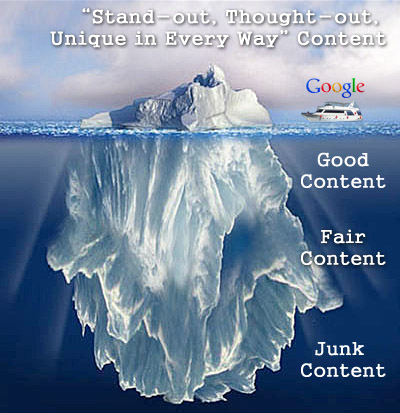All of Your Content Doesn’t Matter Without Meaning
I’ve heard the best time to write is very early in the morning when you’re still in sleep mode. It may help with creativity or in developing concepts. It might even help you spend less mental energy (who couldn’t use more battery life?).
I often write my titles last, but I never go into a content piece without a purpose. And more than a fluffy idea, but an idea that I can qualify as valuable. I wrote a post on Moz about uncovering some of these ideas and measuring their value. I truly believe this extra work ahead of time pays out in the end (read that post to pick up some tips for finding and validating content ideas with data).
The drawbacks of thin content
Once you’re past the data and have some direction, you’re entering the vicinity of the art form known as writing. Semiotics, philosophical theorizing, and representation make your content constructive. If you’re teaching your audience from the place they reside, you will make an even bigger impact. If you don’t know your audience and you’re talking over their heads, you’re going to whiff.
 Sounds logical, right? The truth is, Google loves this type of content. It’s exactly what they want to be ranking since it improves their own brand. Synergy!
Sounds logical, right? The truth is, Google loves this type of content. It’s exactly what they want to be ranking since it improves their own brand. Synergy!
But what I’m still seeing from businesses and content vendors alike are fluffy pieces that are redundant to what’s already been said, cranked out by the thousands, in hopes of winning SEO traffic. I’m also hearing about those uncomfortable conversations between the business and the vendors when the content does absolutely nothing in terms of SEO progress. Sure, they may be written fine, but they are as memorable as Teen Wolf Too.
Google’s Panda updates in 2011 were designed to de-rank thin content. But thin content isn’t just the stuff that’s spun, regurgitated, and published in short chunks. If long-form content is not saying anything, Google’s not going to go for it (at least not for the long term – that’s a pretty safe bet).
Google and content comprehension
See, Google – through the 2013 Hummingbird update – improved its comprehension. It’s improving its use of structured data and semantics and is trying to determine the value of content beyond just keywords. Google’s artificial intelligence system – RankBrain – came about in 2015 to evaluate the relevance of search results. And BERT, announced in 2019, looked deeper into how the context of conversational search queries changes the meaning of a search.
With each of these updates, keywords alone don’t move the needle effectively. Some pages rank even if they don’t contain a keyword, which results in understanding the intent of the search based on previous search data and relationships. More signals outside of the mainstream SEO keyword plays.
Today, search intent plays an increasingly large role in ranking content. Tools like SEMRush integrate an Intent column of their Keyword Magic Tool, to illustrate the purpose of a search in a search engine. Keyword intents can be read by the search engine algorithms to show the proper search results.
The meaning behind my own content
Here is the mental checklist I audit my content ideas against, then audit my final copy against:
- Did I say anything new?
If not, it’s probably better to be a curator, but don’t expect much from SEO here. - Did I say something that will get someone’s attention?
This is marketing – if you’re writing the same old stuff or failing to cut through the noise, you’re not doing effective marketing. Yup – digital has raised the bar quite high. - Is the content part of a strategy?
If you’re posting to get search traffic, that’s not a strategy – that’s a tactic. If you’re using a bunch of tactics chained together with a beginning and an end, with a specific, calculated goal, that’s a strategy. Normally the strategy has a bigger impact in Google today. - Am I really an expert on this topic?
If you’re not, people will know. They won’t share. They won’t comment. They won’t link. You probably won’t get Google’s attention then. Fill your content with your expertise, even if you have to become an expert before you put pen to paper.
If your site is cranking out non-spammy, well-written 500+ articles, but not really saying anything that makes your brand a brand, or gives your users a different point of view, or solves their problems, you’re underwater. You may not have thought of it this way, but reaching the surface may be harder than you realized. Plain content isn’t king anymore.







